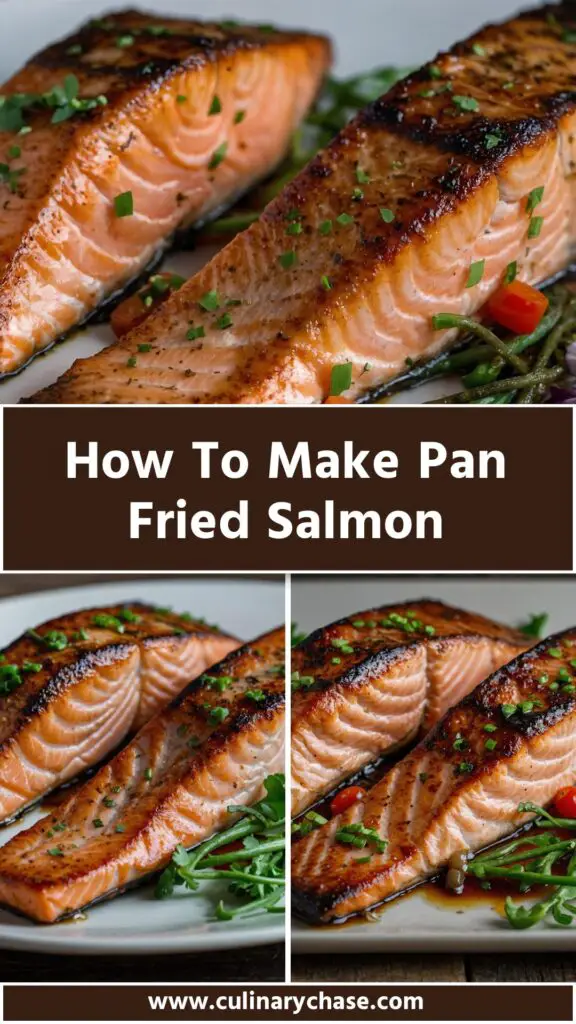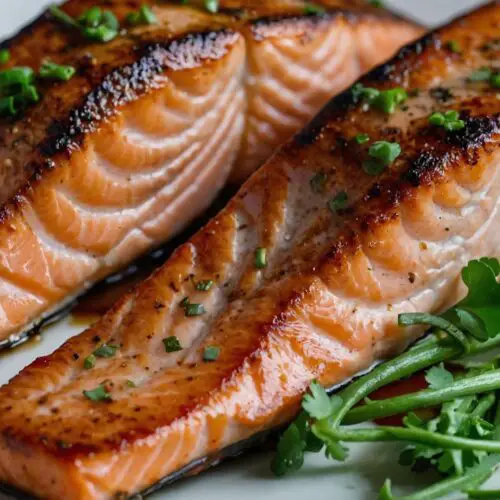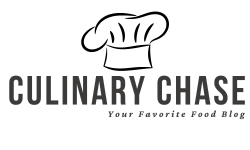How to Make Pan Fried Salmon – Culinary Chase
Let’s take a moment to appreciate the beauty of a perfectly cooked salmon fillet. If you’re like me, you’ve likely experienced that magical moment when the sizzling fish meets the hot pan, releasing its savory essence. Pan-fried salmon can transform a simple meal into a delightful experience.
That’s why I want to share my approach with you. Join me as we dive into the world of making pan-fried salmon that will not just please your taste buds, but also invite compliments from your family and friends.

What is How to Make Pan Fried Salmon?
Pan-fried salmon is a method of cooking that brings out the fish’s natural flavors while giving it a delicious golden crust.
This technique allows the fish to sear beautifully, creating a delightful contrast between the crispy exterior and flaky, tender interior. The best part? It’s an easy and quick dish to whip up, making it perfect for weeknight dinners or fancy occasions.
You will also like the following Lunch and Dinner recipes!
Why You’ll Love This Pan Fried Salmon Recipe
There are many reasons to fall in love with this pan-fried salmon recipe. First and foremost, it’s quick. You can go from barely-there fridge ingredients to a plated masterpiece in less than 30 minutes. Second, the flavor is phenomenal.
With just a handful of ingredients, you’ll discover how truly fulfilling salmon can be. Plus, it’s a healthy option packed with Omega-3 fatty acids, which are great for your heart and well-being. It’s a crowd-pleaser that will surely have everyone asking for seconds.
The Ingredients
Let’s gather our ingredients like a group of friends rallying for a picnic. For this pan-fried salmon, you will need:
Salmon fillets: 4 fillets, each about 6 ounces and approximately 1¼ inches thick (skin removed by fishmonger; it’s optional to keep the skin on).
Extra-virgin olive oil: 1 tablespoon, for that rich flavor.
Fresh lemon zest: 1 teaspoon, to add a refreshing zing.
Sea salt: ½ teaspoon, seasoning our fish just right.
Fresh dill: 1 teaspoon, finely chopped for an aromatic touch.
Freshly cracked black pepper: To taste, because every dish needs a little kick!

Step-by-Step Instructions
Let’s roll up our sleeves and dive into the kitchen! Follow these simple steps to achieve salmon perfection.
Step 1: Preheat the Pan
First things first, heat a non-stick skillet over medium heat. If you have a cast-iron skillet, pull it out for a more beautiful sear! Let it warm up for about 3-4 minutes. You want it hot, but not smoking. Testing the heat is simple: flick a drop of water onto the pan. If it dances and evaporates immediately, you’re good to go.
Step 2: Prepare the Salmon
While the pan is heating, let’s prep our salmon. Pat the fillets dry with paper towels. This removes excess moisture and helps achieve that desired crispy finish. Next, take your olive oil and rub it on both sides of the fillets. T
his not only flavors the salmon but also serves as a barrier against sticking. Sprinkle sea salt, lemon zest, chopped dill, and cracked black pepper on both sides, too. We’re building flavor here!
Step 3: Sear the Salmon
Once the skillet is at the right temperature, gently place your fillets in the pan. Lay them down in the opposite direction of the pan’s heat—this avoids splattering and gives you a nice sizzle. Leave them undisturbed for about 4-5 minutes. The goal is a golden-brown crust.
Step 4: Flip and Finish Cooking
Now, here comes the moment of truth. Carefully flip each fillet using a spatula. Watch for that lovely golden color!
Let the salmon cook for another 3-4 minutes on this side. Salmon is done when it flakes easily with a fork and has an internal temperature of 125-130°F for medium-rare. If you have a meat thermometer, it’s a handy tool here.
Step 5: Serve Hot
Once your salmon is cooked to perfection, remove it from the heat. Serve immediately! Garnish with a sprinkle of fresh dill or a slice of lemon if you’re feeling fancy.
Tips & Tricks
Now that you’ve mastered pan-frying salmon, here are five tips to keep your culinary skills sharp:
Choose Fresh Salmon: Fresh fish is key. Look for firm fillets with a bright color and pleasant smell.
Don’t Crowd the Pan: Give your salmon space to breathe in the pan. Crowding leads to steaming, not searing.
Use a Good Fish Spatula: If you have one, use a fish spatula for flipping. It’s wider and helps prevent the fillets from breaking.
Rest for Flavor: Allow the salmon to rest for a minute or two after cooking. This helps lock in the juices.
Experiment with Seasonings: Try adding garlic powder, smoked paprika, or even a dash of cumin for a twist.
Nutrition Information
You might be curious about what you’re putting into your body. Here’s a quick rundown per serving:
Calories: 367
Protein: 34g
Total Fat: 22g (Saturated Fat: 4g)
Carbohydrates: 0g
Fiber: 0g
Omega-3 Fatty Acids: 2,260mg
With such nutritional benefits, what’s not to love about pan-fried salmon?
Can I Store Pan Fried Salmon?
Absolutely! If you have leftovers, you can store them in an airtight container in the refrigerator. It will keep for up to 3 days. Just remember, I find that reheated salmon can sometimes lose its charm. To refresh it, consider flaking the salmon and tossing it into a salad or pasta dish.

What Can I Serve with Pan Fried Salmon?
The best part about pan-fried salmon is its versatility. Here are a few pairing ideas that elevate the meal:
Crispy roasted vegetables: Think asparagus, Brussels sprouts, or carrots.
Quinoa or rice: A light grain adds substance without overpowering the fish.
French fries or sweet potato wedges: Because who doesn’t love comfort food on their plate?
Simple green salad: A fresh mix of greens with a lemon vinaigrette complements the dish beautifully.
Pasta with garlic and oil: A light, flavorful pasta can carry the meal further.
Variations
Salmon isn’t one-size-fits-all. You can jazz it up depending on your mood. Here are some tasty variations:
Asian-Inspired: Marinate the salmon in soy sauce, ginger, and garlic before cooking. This gives the fish a different, savory profile that deeply satisfies.
Mediterranean Twist: Add kalamata olives, capers, and tomatoes to the pan while cooking. It transforms the dish with bright, luscious flavors.
Spicy Cajun: Season the salmon with Cajun spices before pan-frying. This option brings a fun kick that’s sure to wake your palate.
Honey Garlic Glaze: Brush the fillets with a mixture of honey and minced garlic in the last few minutes of cooking. This caramelizes the glaze and adds a sweet touch.
Crispy Crusted: Coat the fillets in panko breadcrumbs before cooking for a crunchy crust. It adds texture that’s simply irresistible.

How to Make Pan Fried Salmon
Equipment
- Skillet
- pan
Ingredients
- 4 fillets Salmon fillets each about 6 ounces and approximately 1¼ inches thick (skin removed by fishmonger; it’s optional to keep the skin on).
- 1 tablespoon Extra-virgin olive oi for that rich flavor.
- 1 teaspoon Fresh lemon zest to add a refreshing zing.
- ½ teaspoon Sea salt seasoning our fish just right.
- Fresh dill finely chopped for an aromatic touch.
- Freshly cracked black pepper : To taste because every dish needs a little kick!
Instructions
Step 1: Preheat the Pan
- First things first, heat a non-stick skillet over medium heat. If you have a cast-iron skillet, pull it out for a more beautiful sear! Let it warm up for about 3-4 minutes. You want it hot, but not smoking. Testing the heat is simple: flick a drop of water onto the pan. If it dances and evaporates immediately, you’re good to go.
Step 2: Prepare the Salmon
- While the pan is heating, let’s prep our salmon. Pat the fillets dry with paper towels. This removes excess moisture and helps achieve that desired crispy finish. Next, take your olive oil and rub it on both sides of the fillets. T
- his not only flavors the salmon but also serves as a barrier against sticking. Sprinkle sea salt, lemon zest, chopped dill, and cracked black pepper on both sides, too. We’re building flavor here!
Step 3: Sear the Salmon
- Once the skillet is at the right temperature, gently place your fillets in the pan. Lay them down in the opposite direction of the pan’s heat—this avoids splattering and gives you a nice sizzle. Leave them undisturbed for about 4-5 minutes. The goal is a golden-brown crust.
Step 4: Flip and Finish Cooking
- Now, here comes the moment of truth. Carefully flip each fillet using a spatula. Watch for that lovely golden color!
- Let the salmon cook for another 3-4 minutes on this side. Salmon is done when it flakes easily with a fork and has an internal temperature of 125-130°F for medium-rare. If you have a meat thermometer, it’s a handy tool here.
Step 5: Serve Hot
- Once your salmon is cooked to perfection, remove it from the heat. Serve immediately! Garnish with a sprinkle of fresh dill or a slice of lemon if you’re feeling fancy.
Notes
- Choose Fresh Salmon: Fresh fish is key. Look for firm fillets with a bright color and pleasant smell.
- Don’t Crowd the Pan: Give your salmon space to breathe in the pan. Crowding leads to steaming, not searing.
- Use a Good Fish Spatula: If you have one, use a fish spatula for flipping. It’s wider and helps prevent the fillets from breaking.
- Rest for Flavor: Allow the salmon to rest for a minute or two after cooking. This helps lock in the juices.
- Experiment with Seasonings: Try adding garlic powder, smoked paprika, or even a dash of cumin for a twist.
Nutrition
Frequently Asked Questions
Here’s where I tackle questions that often arise when preparing pan-fried salmon.
1. Can I use frozen salmon?
Yes, but be sure to thaw it in the refrigerator overnight before cooking. Thawing allows for even cooking.
2. What’s the best way to know salmon is cooked?
The flesh should be opaque and flake easily with a fork. A meat thermometer is ideal; it should read between 125°F and 130°F for medium-rare.
3. Can I use other types of fish?
Definitely! This method works for trout, tilapia, or cod. Adjust cooking times based on the thickness of the fillet.
4. What’s the best pan to use for frying salmon?
A non-stick skillet or cast-iron skillet works well. Both can create a beautiful sear and prevent sticking.
5. Can I add vegetables to the pan while cooking the salmon?
Of course! Add quick-cooking veggies like zucchini or bell peppers towards the end of cooking to keep them crisp.
Conclusion
By now, you should feel confident about creating a delicious pan-fried salmon dish. It’s straightforward, flexible, and a guaranteed crowd-pleaser. Once you try it, you might find yourself cooking salmon more often than you thought. I hope that you enjoy every moment spent in your kitchen, experimenting with flavors and making memories around the dinner table. So, gear up, grab that skillet, and let the sizzle begin!
